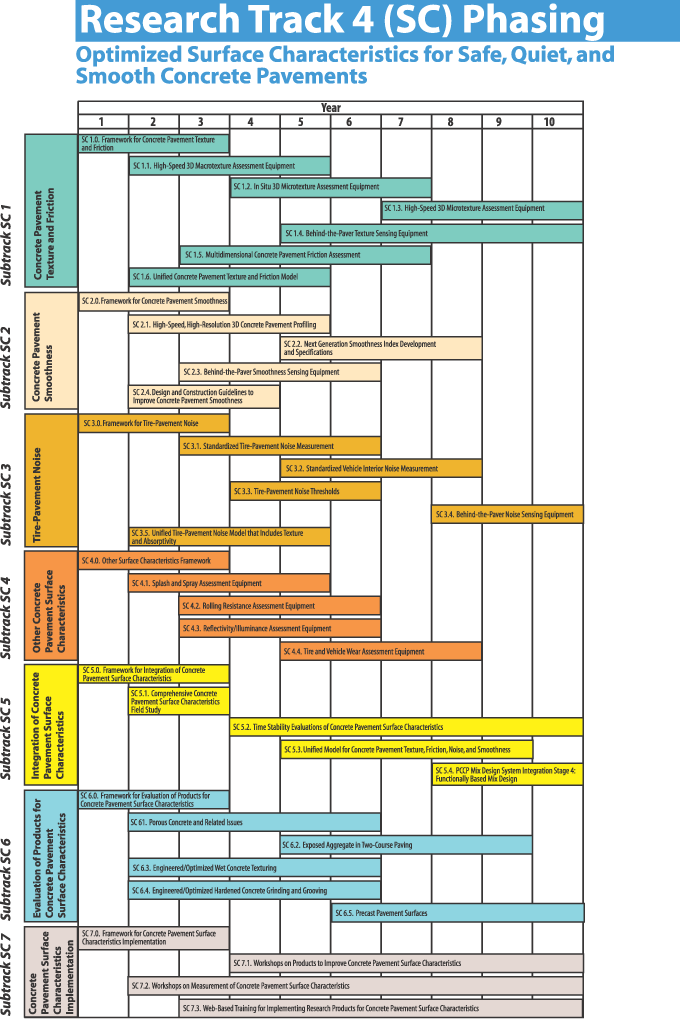U.S. Department of Transportation
Federal Highway Administration
1200 New Jersey Avenue, SE
Washington, DC 20590
202-366-4000
Federal Highway Administration Research and Technology
Coordinating, Developing, and Delivering Highway Transportation Innovations
 |
| This report is an archived publication and may contain dated technical, contact, and link information |
|
Publication Number: FHWA-HRT-05-053 Date: September 2005 |

Figure 4. Track 4 (SC) subtrack and problem statement phasing chart.
Track 4 (SC) subtrack and problem statement phasing chart.The horizontal bar chart in this figure shows the approximate time phasing of the problem statements in track 4, Optimized Surface Characteristics for Safe, Quiet, and Smooth Concrete Pavements (SC), grouped by subtrack across 10 years. There are seven subtracks in track 4: (1) Concrete Pavement Texture and Friction; (2) Concrete Pavement Smoothness; (3) Tire-Pavement Noise; (4) Other Concrete Pavement Surface Characteristics; (5) Integration of Concrete Pavement Surface Characteristics; (6) Evaluation of Products for Concrete Pavement Surface Characteristics; and (7) Concrete Pavement Surface Characteristics Implementation.
In subtrack 1 the problem statements are arranged as follows: Problem Statement SC 1.0. Framework for Concrete Pavement Texture and Friction extends from years 1 to 3; Problem Statement SC 1.1. High-Speed 3D Macrotexture Assessment Equipment extends from years 2 to 5; Problem Statement SC 1.2. In Situ 3D Microtexture Assessment Equipment extends from years 4 to 7; Problem Statement SC 1.3. High-Speed 3D Microtexture Assessment Equipment extends from years 7 to 10; Problem Statement SC 1.4. Behind-the-Paver Texture Sensing Equipment extends from years 5 to 10; Problem Statement SC 1.5. Multidimensional Concrete Pavement Friction Assessment extends from years 3 to 7; and Problem Statement SC 1.6. Unified Concrete Pavement Texture and Friction Model extends from years 2 to 5.
In subtrack 2 the problem statements are arranged as follows: Problem Statement SC 2.0. Framework for Concrete Pavement Smoothness extends from years 1 to 3; Problem Statement SC 2.1. High-Speed, High-Resolution 3D Concrete Pavement Profiling extends from years 2 to 5; Problem Statement SC 2.2. Next Generation Smoothness Index Development and Specifications extends from years 5 to 8; Problem Statement SC 2.3. Behind-the-Paver Smoothness Sensing Equipment extends from years 3 to 6; and Problem Statement SC 2.4. Design and Construction Guidelines to Improve Concrete Pavement Smoothness extends from years 2 to 4.
In subtrack 3 the problem statements are arranged as follows: Problem Statement SC 3.0. Framework for Tire-Pavement Noise extends from years 1 to 3; Problem Statement SC 3.1. Standardized Tire-Pavement Noise Measurement extends from years 3 to 6; Problem Statement SC 3.2. Standardized Vehicle Interior Noise Measurement extends from years 5 to 8; Problem Statement SC 3.3. Tire-Pavement Noise Thresholds extends from years 4 to 6; Problem Statement SC 3.4. Behind-the-Paver Noise Sensing Equipment extends from years 8 to 10; and Problem Statement SC 3.5. Unified Tire-Pavement Noise Model that Includes Texture and Absorptivity extends from years 2 to 5.
In subtrack 4 the problem statements are arranged as follows: Problem Statement SC 4.0. Framework for Other Concrete Pavement Surface Characteristics extends from years 1 to 3; Problem Statement SC 4.1. Splash and Spray Assessment Equipment extends from years 2 to 5; Problem Statement SC 4.2. Rolling Resistance Assessment Equipment extends from years 2 to 5; Problem Statement SC 4.3. Reflectivity/Illuminance Assessment Equipment extends from years 3 to 6; and Problem Statement SC 4.4. Tire and Vehicle Wear Assessment Equipment extends from years 5 to 8.
In subtrack 5 the problem statements are arranged as follows: Problem Statement SC 5.0. Framework for Integration of Concrete Pavement Surface Characteristics extends from years 1 to 3; Problem Statement SC 5.1. Comprehensive Concrete Pavement Surface Characteristics Field Study extends from years 2 to 3; Problem Statement SC 5.2. Time Stability Evaluations of Concrete Pavement Surface Characteristics extends from years 4 to 10; Problem Statement SC 5.3. Unified Model for Concrete Pavement Texture, Friction, Noise, and Smoothness extends from years 5 to 9; and Problem Statement SC 5.4. PCC Pavement Mix Design System Integration Stage 4: Functionally Based Mix Design extends from years 4 to 10.
In subtrack 6 the problem statements are arranged as follows: Problem Statement SC 6.0. Framework for Evaluation of Products for Concrete Pavement Surface Characteristics extends from years 1 to 3; Problem Statement SC 6.1. Porous Concrete and Related Issues extends from years 2 to 6; Problem Statement SC 6.2. Exposed Aggregate in Two-Course Paving extends from years 5 to 9; Problem Statement SC 6.3. Engineered/Optimized Wet Concrete Texturing extends from years 2 to 6; Problem Statement SC 6.4. Engineered/Optimized Hardened Concrete Grinding and Grooving extends from years 2 to 6; and Problem Statement SC 6.5. Precast Pavement Surfaces extends from years 6 to 10.
In subtrack 7 the problem statements are arranged as follows: Problem Statement SC 7.0. Framework for Concrete Pavement Surface Characteristics Implementation extends from years 1 to 3; Problem Statement SC 7.1. Workshops on Products to Improve Concrete Pavement Surface Characteristics extends from years 4 to 10; Problem Statement SC 7.2. Workshops on Measurement of Concrete Pavement Surface Characteristics extends from years 2 to 10; and Problem Statement SC 7.3. Web-Based Training for Implementing Research Products for Concrete Pavement Surface Characteristics extends from years 2 to 10.